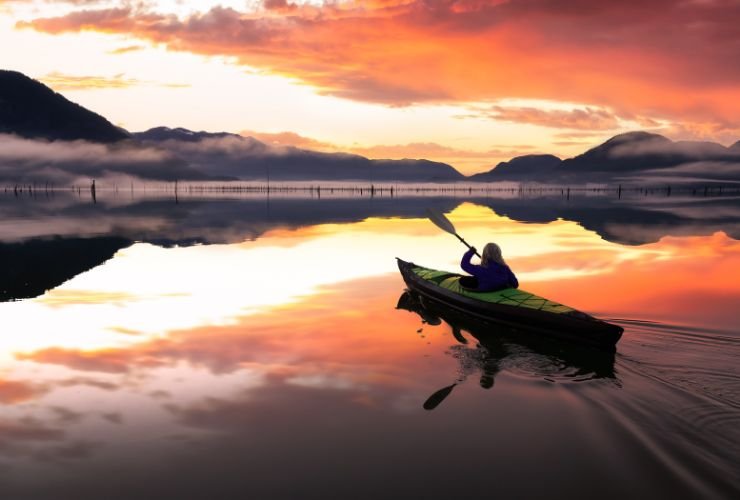Kayaking at night has its own unique charms and challenges. This guide will walk you through everything you need to know and prepare to have a fantastic nocturnal paddling experience.
While kayaking at night can be a unique experience, there are some crucial things you need to know before you begin.
Key Takeaways
- Night kayaking offers a unique perspective and you can enjoy stargazing, observe nocturnal wildlife, and experience tranquility on the water.
- It’s also risky because of reduced visibility, potential encounters with wildlife, and the difficulty of seeking help in emergencies.
- Before going kayaking at night, ensure you have the necessary equipment, including white lights, visual distress signals, and noise-making devices.
- Familiarize yourself with the legal requirements for night kayaking in the US and the state you’ll be kayaking in.
- When planning your route, consider factors like tides and weather conditions. Use navigation tools and be aware of your surroundings.
Is Kayaking at Night Legal?
Sadly, the legality of night kayaking is not a simple yes or no answer. For the most part, the US coast guard requires that you follow these rules:
- Your kayak must be fitted with a white light between sunset and sunrise (which will change depending on your location). This can be either a handheld light or something fixed into your hull.
- You must have some form of visual distress signals. These can either be handheld red flares or distress lights that are commonly sold in outdoor stores.
- You must have some way of producing noise (this could be a whistle or anything that makes a loud noise).
These are the legal requirements from the US coast guard – these are all non-negotiable, and you MUST have all three of these equipped if you intend to do any night kayaking ANYWHERE in the US.
Failure to do so is not only considered breaking the law but can also put your life in danger.
There Are Some State Laws To Be Aware Of
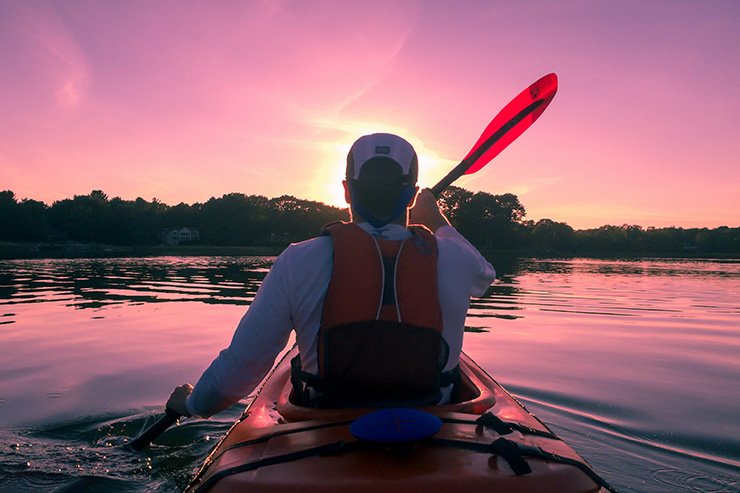
There are not only federal laws to consider but also local laws.
Fortunately, these state laws are not excruciatingly complicated. In many states, you should be ok if you have the three items listed above.
In some cases, there are times when you’re prohibited from kayaking at night.
One such case is Florida – which states the following:
“Personal watercraft may not be operated from 1/2 hour after sunset to 1/2 hour before sunrise, even if navigation lights are used.”
You should check your state’s local regulations around kayaking at night: there are official state websites that have updated information.
Be aware that these laws are not in place for no reason – restricted operating hours can be when visibility is at its lowest or there is wildlife around that is dangerous or endangered.
Safety Precautions and Preparations for Kayaking at Night
There are some basic safety preparations to make that will help make any night kayak excursions go smoothly.
This section will cover what you need to know and all the equipment you should take with you.
Choosing a Suitable Location for Night Kayaking
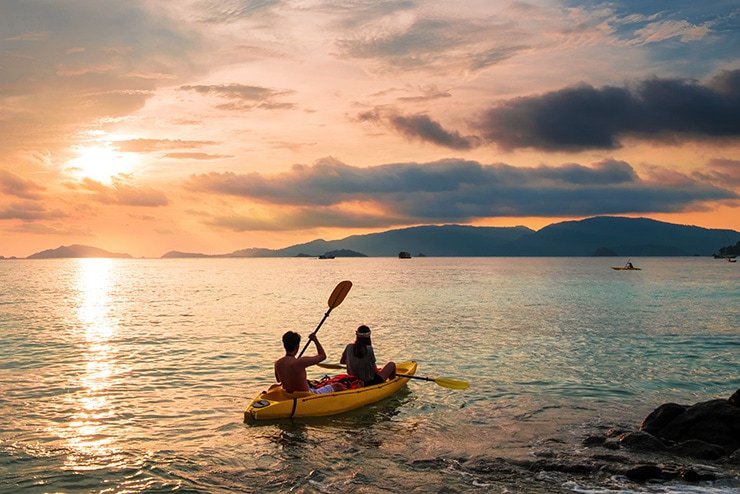
Location is always an important piece of the puzzle in kayaking, but its importance gets upgraded when talking about nighttime kayaking.
Any night kayaking will have fewer people around, and the lack of visibility means you need to be very familiar with the water route, or you should consider going with a guide.
Getting lost can be a legitimate risk even in daytime paddling, but in nighttime paddling, mistakes can be even more costly.
Any time spent planning a night kayaking expedition is time well spent, and the more familiar you are with the water, the better.
It goes without saying, but nighttime kayaking around waterways you’re not familiar with is a recipe for disaster.
Checking Weather and Water Conditions
The nighttime experience can sometimes lull us into a false sense of security, but the weather doesn’t have an off switch at night.
It can also be harder to detect distant changes in weather that you might run into later, so you should always have an eye on the weather forecast.
As with the above, familiarity with the local area and its usual weather patterns can be a boon, as you’ll more instinctively know when the weather and water conditions can take a turn for the worse.
It’s also essential to check for information about the rising and falling tides so you’re not caught off guard.
Essential Safety Equipment and Gear
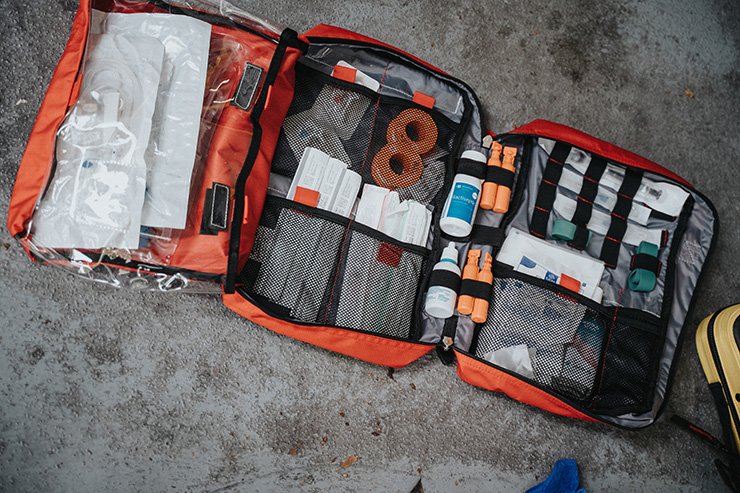
There’s some vital safety equipment that you should always bring on any night paddling adventures:
- Life jacket (sometimes referred to as a PFD or Personal Flotation Device).
- A flashlight (do not depend on your phone for light, it is fragile and can run out of power fast).
- Spare batteries for your flashlight.
- White lights – These can be handheld or fixed light, sometimes referred to as a “Lighted lantern.”
- A flair or red light to alert anyone to your position if you need assistance.
- A phone or VHF radio for communication.
- A whistle or anything that can make some noise to alert people to your position in case you need assistance.
- First Aid Kit
This is your most essential safety equipment, you might also consider bringing a dry bag to store anything else you want to take with you. It can be a good idea to put a spare change of clothes or any other bits and pieces you want to take with you.
Understanding the Challenges of Navigating in the Dark
Navigating around in the dark has its own challenges. There is less reliance on visual information, which is the sense humans rely on most to navigate naturally.
Instead, you have the option to use technology that can help you keep on track.
There are many such tools available for you to use – the section below will cover every handy tool you can take with you, as well as the equipment you need and some things to be aware of.
Use Navigation Tools, Such as Compasses and Gps Devices
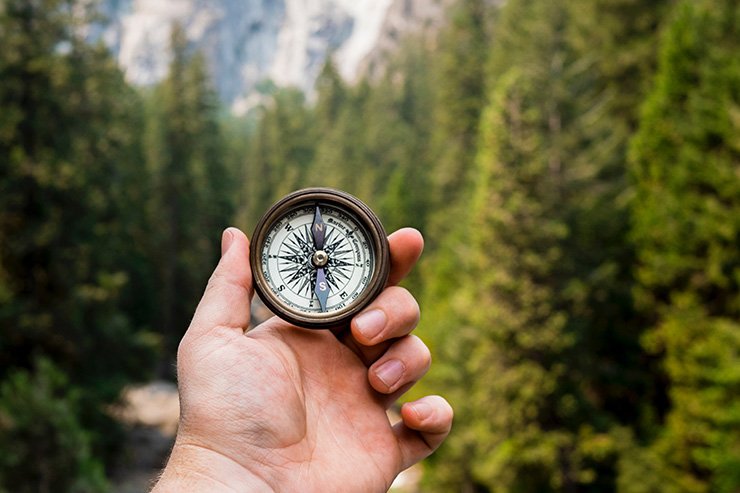
There are some handy pieces of equipment you can use to make any night kayaking a little easier.
The old but golden compass is a fantastic option. As long as you know which way the shore is, it’s difficult to get lost. Plus, another advantage of the compass is that it doesn’t need to be charged up – so a dead battery won’t leave you high and dry, so to speak.
However, GPS equipment is also an option, which until just a few years ago would have been expensive, awkward, and most likely not very practical for most kayakers.
Fortunately, modern smartphones have the capacity for a GPS app that can track your position. However, the quality and usefulness of this information depends on where you are.
If you’re kayaking in a group familiar with the waterway, navigation isn’t as much of a concern. But if you’re solo kayaking, then navigation is something you’ll have to spend some time thinking about.
Get Familiar With the Water Body and Route Planning
As mentioned, night kayaking is not something you should do over an area that you’re not familiar with unless you have a guide to take you around the area.
For anyone who doesn’t have a guide, it’s better to paddle around in the day first and get familiar with the water, then get as much information as you can about the area. There will likely be a few adventurous souls who can give you some pointers.
The more information you have the better. You’re also going to want to build up an accurate picture of what the water is like on a bad and good day. You’ll also want to get familiar with the most common routes on the waterway.
How much you need to do, depends on what kind of water you’re on. If you’re on a river, there isn’t as much to worry about, but once you’re in the sea, there’s much more to consider.
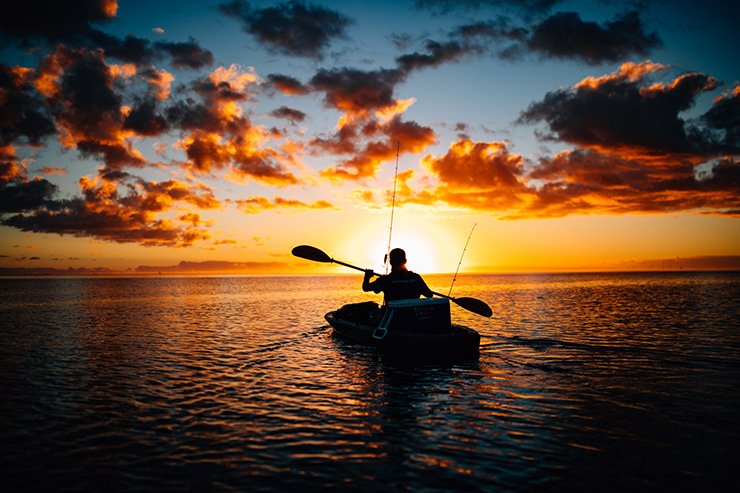
Get Some Lights for Your Kayak
As mentioned before, having the correct lights for the job you need is quite an important part of good nighttime paddling.
Lights are part of safety gear, but they can also be used to help you navigate. That said, not just any old light will do. Some specific types do the job better than others.
Types of Lights Suitable for Kayaking
A standard white light is the most basic safety gear for any nighttime excursion.
These are often part of “visibility kits” and are sold in most sports or outdoor stores. They have long run times (often up to and exceeding 160 hours) and are an excellent source of white light.
There are also VDS lights. These can take the form of handheld red flares or an electric torch which is sometimes classified as an “electric distress light.” VDS can also sometimes comes equipped with oscillating red and green lights.
Other lights can be used as navigation aids – such as a lighted lantern.
Required Lighting Regulations and Guidelines
The required lighting regulations for kayak lights are as follows:
One 360-degree white light OR one white stern light and red and green light for the bow. You don’t need both, but you do need one.
This lighting requirement is to help other vessels see which direction you’re coming from. It can also be handy if you get a bit off course and end up in a shipping lane!
Mounting Lights on Your Kayak for Visibility
Lighted lanterns can also be attached to your kayak hull, which can help you navigate in the dark.
White lights or tri-color systems (the light at the stern and red and green lights for the bow discussed above) can also be mounted onto your kayak hull.
Tri-color light systems are considered the safest by far but can be a bit finicky to install.
The Advantages of Night Kayaking

Night kayaking offers some incredibly unique opportunities that you can’t get anywhere else – these are just some of the benefits that await you should you decide to go on this undertaking.
Opportunity to Stargaze
If you’re doing any night kayaking on the ocean or even on a lake, there is nothing quite like star gazing on open water.
The sky looks more open, and you can snap some truly once-in-a-lifetime pictures and see sights that a lot of people will never experience for themselves.
If you’re someone who is willing to work for a unique vista, then you absolutely will not regret this.
Observe Nocturnal Wildlife
Speaking of sights to see, there is also a unique opportunity to observe aquatic life and otherwise observe nature in an environment that is difficult to find anywhere else.
The potential to view nocturnal wildlife in a location with minimal disruption from humans can give you a unique insight into the natural world – and is also one of the primary reasons many paddlers choose to go night kayaking.
Quiet and Peaceful Environment
The other big benefit of night kayaking is the peace and quiet – there is very minimal environmental noise, as there are fewer boats and there aren’t many other people around either.
A lot of paddlers enjoy the experience of having their senses “enhanced,” and it’s easy to feel in the zone when you’re doing some nighttime paddling.
The Risks of Night Kayaking
While there are some advantages to night kayaking, there are also some disadvantages that you should be aware of.
Reduced Visibility
It goes without saying, but it can be hard to see where you’re going, even with a good light setup. It makes everything a little bit trickier and requires you to pay attention to your actions and be completely in the moment.
If you’re someone who likes to “switch off” when kayaking, then nighttime paddling may not be the best thing for you.
Disruption to Wildlife (That Isn’t Used to Humans)
While the opportunity to observe wildlife in a unique environment is a special benefit of kayaking, it can also be a disadvantage depending upon how you view it.
In many cases, nocturnal animals are even less used to humans than most daytime animals. Lights on a kayak can be a confusing stimulus to this wildlife, it may cause them distress, and it may cause them to view you as a threat.
Although in many cases, you may simply be ignored.
Failing To Prepare Carefully
This has been mentioned a few times, but proper planning is essential for good night kayaking.
Most kayak expeditions benefit from good planning, but this goes triple here. You should know you’re planned route well, double-check your safety equipment and ensure you have everything you need.
Conclusion
Kayaking at night can be an incredibly fulfilling and exciting experience. But you should always ensure that you plan for your trip properly and make sure that you have everything you need before setting out.
To kayak at night can be a wonderful experience, but the water should be respected, and you or your group should have a good grasp of navigation before setting out (or consider getting a guide for the area).
Thank you for reading – if you found the information here useful, then please like, comment, or share.

